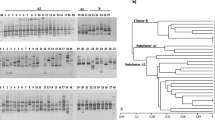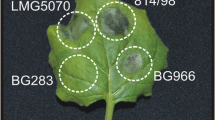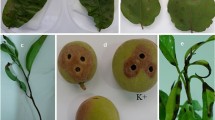Abstract
Infection of fruit trees by Pseudomonas syringae is a potentially serious problem that may limit the establishment and sustained productivity of pome and stone fruit orchards in Serbia. To estimate possible diversity of Pseudomonas syringae fruit trees strains, we collected a set of strains in several areas of Serbia. The samples were taken from infected orchards with raspberry, plum, cherry, sour cherry, peach, pear and apple trees. Genetic diversity of P. syringae strains isolated from fruit trees was determined by using SpeI macrorestriction analysis of genomic DNAs by pulsed-field gel electrophoresis (PFGE) and REP-PCR. Molecular analysis showed that most of isolates had unique profiles, with the exception of isolates from plum and cherry that displayed profiles identical to each other and similar to P. syringae pv. morsprunorum. The study presented here clearly demonstrates the discriminative power of molecular techniques in enabling a detailed analysis of the genetic variations between strains of P. syringae from different pome and stone fruit hosts in Serbia.





Similar content being viewed by others
References
Ausubel, F. M., Brent, R., Kingston, R. E., Moore, D. D., Seidman, J. G., Smith, J. A., & Struhl, K. (Eds.). (1992). Current protocols in molecular biology, Vol. I. New York: Greene Publishing Associates and Wiley-Interscience.
Balaz, J., & Arsenijevic, M. (1989). Further investigations on the Pseudomonas syringae pathovar as a pathogen of sour cherry fruits in Yugoslavia. (Paper presented at the 7th Int. Conf. Plant Path. Bact., Budapest, Hungary, pp. 515–520.
Braun-Kiewnick, A., & Sands, D. C. (2001). Pseudomonas. In N. Schaad, J. B. Jones, & W. Chun (Eds.), Laboratory guide for identification of plant pathogenic bacteria (pp. 84–117). St. Paul: APS PRESS, American Phytopathological Society.
Burkowicz, A., & Rudolph, K. (1994). Evaluation of pathogenicity and of cultural and biochemical tests for identification of Pseudomonas syringae pathovars syringae, morsprunorum, and persicae from fruit trees. Journal of Phytopathology, 141, 59–76.
Clerc, A., Manceau, C., & Nesme, X. (1998). Comparison of randomly amplified polymorphic DNA with amplified fragment length polymorphism to assess genetic diversity and genetic relatedness within genospecies III of Pseudomonas syringae. Applied and Environmental Microbiology, 64, 1180–1187.
de Bruijn, F. J. (1992). Use of repetitive (repetitive extragenic palindromic and enterobacterial repetitive intergeneric consensus) sequences and the polymerase chain reaction to fingerprint the genomes of Rhizobium meliloti isolates and other soil bacteria. Applied and Environmental Microbiology, 58, 2180–2187.
Felsenstein, J. (1993). Phylogeny inference package version 3.5 c. Seattle, Wash: Department of Genetics, University of Washington.
Ferrente, P., & Scotrichini, M. (2010). Molecular and phenotypic features of Pseudomonas syringae pv. actinidiae isolated during recent epidemics of bacterial canker on yellow kiwifruit (Actinidia chinensisi) in central Italy. Plant Pathology, 59, 954–962.
Gonzalez, A. J., Landeras, E., & Carmen, M. M. (2000). Pathovars of Pseudomonas syringae causing bacterial brown spot and halo blight in Phaseolus vulgaris L. are distinguishable by ribotyping. Applied and Environmental Microbiology, 66, 850–854.
Grothues, D., & Rudolph, K. (1991). Macrorestriction analysis of plant pathogenic Pseudomonas species and pathovars. FEMS Microbiology Letters, 79, 83–88.
Guven, K., Jones, B., Momol, M. T., & Dickstein, E. R. (2004). Phenotypic and genetic diversity among Pseudomonas syringae pv. phaseolicola. Journal of Phytopathology, 152, 658–666.
Hugh, R., & Leifson, E. (1953). The taxonomic significance of fermentative versus oxidative metabolism of carbohydrates by various Gram-negative bacteria. Journal of Bacteriology, 66, 24–26.
Ivanovic, Z., Zivkovic, S., Starovic, M., Josic, D., Stankovic, S., & Gavrilovic, V. (2009). Diversity among Pseudomonas syringae strains originating from fruit trees in Serbia. Archives of Biological Sciences, 61(4), 863–870.
Klement, Z. (1990). Inoculation plant tissues. Cancer and dieback disease. In Z. Klement, K. Rudolph, & D. Sands (Eds.), Methods in phytobacteriology (pp. 105–106). Budapest: Akademiai Kiado.
Kojic, M., Strahinic, I., Fira, D., Jovcic, B., & Topisirovic, L. (2006). Plasmid content and bacteriocin production by five strains of Lactococcus lactis isolated from semi-hard homemade cheese. Canadian Journal of Microbiology, 52, 1110–1120.
Latorre, B. A., & Jones, A. L. (1979). Pseudomonas morsprunorum, the cause of bacterial canker of sour cherry in Michigan, and its epiphytic association with P. syringae. Phytopathology, 69, 335–339.
Lelliott, R. A., & Stead, D. E. (1987). Methods for the diagnosis for bacterial disease of plants. Oxford, London, Edinburgh: British Society for Plant Pathology, Blackwell Scientific Publications.
Louws, F. J., Fulbright, D. W., Stephens, C. T., & de Bruijn, F. J. (1994). Specific genomic fingerprints of phytopathogenic Xanthomonas and Pseudomonas pathovars and strains generated with repetitive sequences and PCR. Applied and Environmental Microbiology, 60, 2286–2295.
Louws, F. J., Bell, J., Medina-Mora, C. M., Smart, C. D., Opgenorth, D., Ishimaru, C. A., Hausbeck, M. K., de Bruijn, F. J., & Fulbright, D. W. (1998). rep-PCR–mediated genomic fingerprinting: a rapid and effective method to identify Clavibacter michiganensis. Phytopathology, 88, 862–868.
Lupski, J. R., & Weinstock, G. M. (1992). Short, interspersed repetitive DNA sequences in prokaryotic genomes. Journal of Bacteriology, 174, 4525–4529.
Manceau, C., & Brin, C. (2003). Pathovars of Pseudomonas syringae are structured in genetic populations allowing the selection of specific markers for their detection in plant samples. In N. S. Iacobellis, A. Collmer, S. W. Hutcheson, et al. (Eds.), Pseudomonas syringae and related pathogens (pp. 503–512). Dordrecht: Kluwer Academic Publishers.
Manceau, C., & Horvais, A. (1997). Assessment of genetic diversity among strains of Pseudomonas syringae by PCR restriction fragment length polymorphism analysis of rRNA operons with special emphasis on P. syringae pv. tomato. Applied and Environmental Microbiology, 63, 498–505.
Mo, Y. Y., & Gross, D. C. (1991). Plant signal molecules activate the syrB gene, which is required for syringomycin production by Pseudomonas syringae pv. syringae. Journal of Bacteriology, 173, 5784–5792.
Nei, M., & Li, W. H. (1979). Mathematical model for studying genetic variation in terms of restriction endonucleases. Proceedings of the National Academy of Sciences of the United States of America, 76, 1619–1626.
Obradovic, A., Gavrilovic, V., Ivanovic, M., & Gasic, K. (2008). Pseudomonas blight of raspberry in Serbia. In: M. Fatmi, A. Collmer, N.S. Iacobellis, J.W. Mansfield, J. Murillo, N.W. Schaad, M. Ullrich (eds.) Pseudomonas syringae pathovars and related pathogens—identification, epidemiology and genomics (pp. 413–417). Springer Science + Business Media B. V.
Paterson, J. M., & Jones, A. L. (1991). Detection of Pseudomonas syringae pv. morsprunorum on cherries in Michigan with a DNA hybridization probe. Plant Disease, 75, 893–896.
Renick, L. J., Cogal, A. G., & Sundin, G. W. (2008). Phenotypic and genetic analysis of epiphytic pseudomonas syringae populations from sweet cherry in Michigan. Plant Disease, 92, 372–378.
Rico, A., & Preston, G. M. (2008). Pseudomonas syringae pv. tomato DC3000 uses constitutive and apoplast-induced nutrient assimilation pathways to catabolize nutrients that are abundant in the tomato apoplast. Molecular Plant-Microbe Interactions, 21, 269–282.
Sawada, H., Suzuki, F., Matsuda, I., & Saitou, N. (1999). Phylogenetic analysis of Pseudomonas syringae pathovars suggests the horizontal gene transfer of argK and the evolutionary stability of hrp gene cluster. Journal of Molecular Evolution, 49, 627–644.
Scholz, B. K., Jakobek, J. L., & Lindgren, P. B. (1994). Restriction fragment length polymorphism evidence for genetic homology within a pathovar of Pseudomonas syringae. Applied and Environmental Microbiology, 60, 1093–1100.
Sorensen, K. N., Kim, K.-H., & Takemoto, J. Y. (1998). PCR detection of cyclic lipodepsinonapeptide-producing Pseudomonas syringae pv. syringae and similarity of strains. Applied and Environmental Microbiology, 61, 226–230.
Suslow, T. V., Schroth, M. N., & Isaka, M. (1982). Application of rapid method for Gram differentiation of plant pathogenic and saprophytic bacteria without staining. Phytopathology, 72, 917–918.
Vicente, J. G., & Roberts, S. J. (2007). Discrimination of Pseudomonas syringae isolates from sweet and wild cherry using rep-PCR. European Journal of Plant Pathology, 117, 383–392.
Vicente, J. G., Alves, J. P., Russell, K., & Roberts, S. J. (2004). Identification and discrimination of pseudomonas syringae isolates from wild cherry in England. European Journal of Plant Pathology, 110, 337–351.
Zhang, Y., & Geider, K. (1997). Differentiation of Erwinia amylovora strains by pulsed-field gel electrophoresis. Applied and Environmental Microbiology, 63, 4421–4426.
Acknowledgments
This work was supported by the Ministry of Education and Science, Republic of Serbia (Grants No. 173026 and 31018)
Author information
Authors and Affiliations
Corresponding author
Rights and permissions
About this article
Cite this article
Ivanović, Ž., Stanković, S., Živković, S. et al. Molecular characterization of Pseudomonas syringae isolates from fruit trees and raspberry in Serbia. Eur J Plant Pathol 134, 191–203 (2012). https://doi.org/10.1007/s10658-012-9978-4
Accepted:
Published:
Issue Date:
DOI: https://doi.org/10.1007/s10658-012-9978-4




